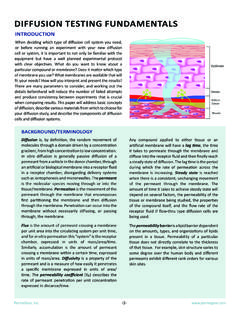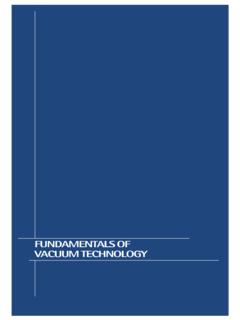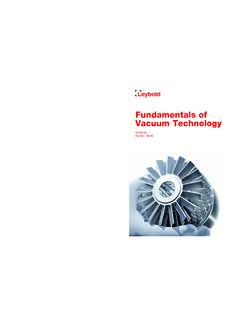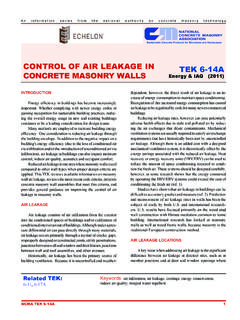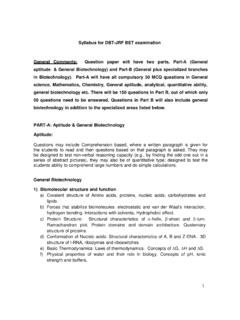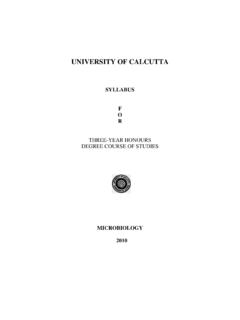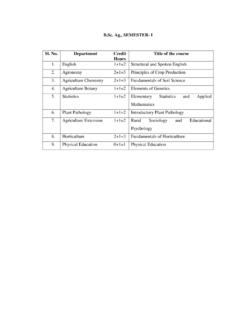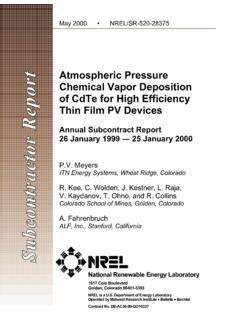Transcription of Filtration Standards and Applications - ASHRAE Arkansas
1 Filtration Standards and Applications Arkansas Chapter of ASHRAE . December 6 & 7, 2006. Outline Important Aspects of Particulate Filters Particulate Filter Test Standards Local Codes & Requirements Application Summary Discussion on Gaseous Contaminants and Gas Phase Filter Test Standards and Applications Are Saved For Another Time Why Filter? Remove Dust, Dirt, & Microbials Keep Equipment & Systems Clean Reduce Maintenance Cost Reduce Energy Cost Keep the Indoor Environment Clean Improve Health Improve Cleanliness What is This? What is That? What To Filter? Particle Particle Size ( m). Respirable Particles <5. Viruses Individual Bacteria 5. Fungal & Bacteria Spores 2 - 10. Pollen Grain 10 - 100. Dust <100. Human Hair (Diameter) 100 - 150. Excerpted from 2005 ASHRAE Handbook Fundamentals, Chapter 12.
2 Filtration Methods Straining Inertial Impingement Interception Diffusion Electrostatic All Methods Are Used in Capturing Particles in Most Filters; However, Filters are Typically Designed with a Dominant Method Straining The Particle is Larger Than the Opening Between Media Fibers A Dominant Method of Particulate Removal in Low Efficiency Air Filters (Pleated Prefilters). Inertial Impingement A Large, Dense Particle Collides with the Fibers and Attaches to the Media Adhesives or Tackifiers Can Be Used to Enhance Capture Efficiency A Dominant Method of Particulate Removal in Low Efficiency Air Filters (Flat Panel Prefilters). Interception Particle Follows Airstream at Lower Velocities and Contacts Fiber Through Weak Intermolecular attractions (Van Der Waals Forces).
3 The Dominant Method of Particulate Removal in Medium Efficiency Air Filters (Bags and Extended Surface Final Filters). Diffusion Small Particles Collide with the Air Molecules and Move in An Erratic Path (Brownian Movement) and Attaches to the Media Fibers The Dominant Method of Particulate Removal in High Efficiency Air Filters (HEPA Filters). Electrostatic Effects An Electrostatic Charge Is applied to the Fiber that Can Produce an Attracting Force if the Particle is of Opposite Charge Passive (One-Time, Initial) and Regenerative Charges The Dominant Method of Particulate Removal in Metal Panel Prefilters and Some Room Purifiers Effects of Filtering Restricts Airflow Added Pressure Drop Requires Energy Requires Space and Cost Requires Additional Equipment / Frames Replacement Additional Maintenance Is It Worth It?
4 60% of the Service Calls on Air Conditioning Units Could Be Reduced if the Dirt Was Removed From the Airstream Before The Components.. How to Value Differences Dust Removal Efficiency The Percentage of Airborne Particulate the Filter Will Remove ( ASHRAE Standards and Handle this Differently and Both are Applicable). Dust Holding Capacity The Amount of Dust the Filter Will Hold To a Maximum Resistance Value ( ASHRAE Standard Only). Filter Resistance As a Function of Airflow & Dust Load Test Standards Particulate Filter Test Standards ASHRAE Standard - 1992. ASHRAE Standard 1999. UL Standard 900 (Flammability). US Military Standard MIL-STD-282 DOP. Method for HEPA Filters International (CEN EN 779:1993, Others). ASHRAE Standard - 1992. Atmospheric Dust Spot Efficiency Test ASHRAE Dust Weight Arrestance Test ASHRAE Dust Holding Capacity Test Atmospheric Dust Spot Efficiency Test The Dust Spot Test Measures the Ability of a Filter to Reduce Soiling of Fabrics and Building Interior Surfaces using Unconditioned Outside Air Variety and Variability of Atmospheric Dust May Cause the Same Filter to Test at Different Dust Spot Efficiencies at Different Locations ASHRAE Standard 1992.
5 Test Apparatus ASHRAE Dust Weight Arrestance Test The ASHRAE Dust Weight Arrestance Test Measures The Amount of Dust (By Weight Fraction) The Filter Will Capture Requires High Degree of Standardization of Testing Apparatus More Suited for Low to Medium Efficiency Air Filters ASHRAE Dust Holding Capacity Test Measured Amounts of ASHRAE Dust are Used to Artificially Load the Filters in Hours and Not Months ASHRAE Dust is Not Atmospheric Dust;. So, Results May Vary Greatly in Actual Installations ASHRAE Standard Actual Test Report Excerpt Why a Needed a Means to Measure Removal Efficiency by Particle Size Needed more Mandatory (Code). Language Needed More Reliable and Verifiable Results ASHRAE Standard 1999. Test Apparatus ASHRAE Standard - 1999. Twelve (12) Ranges of Particle Counts are Taken Over a Range of Particles Six (6) Times for a Total of Seventy Two (72) Data Points For Each Measurement, the Filtration Efficiency is Stated as a Ratio of Downstream-to-Upstream Particle Count Result?
6 MERV. The Lowest Values then Determine the Composite Minimum Efficiency Curve This Table Excerpted from ASHRAE Standard - 1999. This Table Excerpted from ASHRAE Standard - 1999. and Coexist Used for MERV 1-4 Gaining Popularity filters Some Manufacturers Many Local Test New Products Standards Reference Only Using and Dust Spot Table E-1 is a Good Efficiency Tests Crossover Reference Dust Holding Chart Capacity Has Merit Now You Have Met MERV. Next Steps for Filter Testing ASHRAE Standard Addendum A: Reference Filter Check; (Approved and Included). Addendum B: Incorporating Elements of Into (Waiting for More Data ). Addendum C: Conditioning Step (Waiting for More Data ). Global Standards for Filter Testing (ISO)? ASHRAE Journal Article, August, 2006, Page 58.
7 UL Standard 900. The UL 900 Standard is Designed to Determine Combustibility and the Amount of Smoke Generated for Air Filter Units Under Test A Methane Flame is Ignited on the Upwind Side of the Filter, Resulting in a Direct Flame Against the Filter, Which is Maintained For Three (3) Minutes UL Standard 900 (Cont.). Class 1 Air Filters No Flames or Sparks May Pass Through the Filter and Only a Small Amount of Smoke Can Be Generated Class 2 Air Filters Limited Flaming and Sparking are Acceptable and a Larger Amount of Smoke May be Generated US Military Standard MIL-STD- 282 For HEPA Filters Reserved For a Later Date Codes and Requirements 2003 Arkansas Mechanical Code 2005 Arkansas Hospital Rules & Regulations American Institute of Architects (AIA). Guidelines for Design and Construction of Health Care Facilities Joint Commission: A Guide To Managing Indoor Air Quality in Health Care Organization ASHRAE Standard - 2004.
8 Proposed ASHRAE Standards 170P & 180P. 2003 Arkansas Mechanical Code Section 605 Air Filters Requires: Heating and Air Conditioning Equipment to be Provided with Approved Air Filters Filters to Be Installed in the Return Air System, Upstream of Any Heat Exchanger or Coil Filters to be Listed and Labeled 2005 Arkansas Hospital Rules and Regulations References ASHRAE Standard Values & AIA Guidelines for Design and Construction of Health Care Facilities This Table Excerpted from Section 74, 2005 Rules and Regulations for Hospitals and Related Institutions in Arkansas AIA Guidelines for Design and Construction of Health Care Facilities References ASHRAE Standard Requires a Manometer across each filter Bed Having a Required Efficiency of 75% or more For Individual Room Units, a Minimum of 68% Weight Arrestance Filters Are to Be Used ( ASHRAE ).
9 This Table Excerpted from Section of the 2001 Edition of AIA. Guidelines for Design and Construction of Health Care Facilities NFPA Standard 90A. Requires Filters To be Renewed or Cleaned when the Resistance to Airflow has Increased to Two Times the Original Resistance or When the Resistance Has Reached a Value of Recommended Replacement by the Manufacturer. Avoid Gaps Between Filter Sections, This Information Excerpted from Annex B: Maintenance of the 2002. Edition of NFPA Standard 90A. Joint Commission: A Guide To Managing Indoor Air Quality in Health Care Organization Composite Filter Banks with a Final Filter Efficiency of at Least 95%. Removal of Particles of 1 Micron Size is the Critical Quality Target Does This Contradict Current 2005. Arkansas Hospital Rules and Regulations?
10 This Information Excerpted from A Guide To Managing Indoor Air Quality in Health Care Organization, 1997. ASHRAE Standard Section States That the Minimum of a MERV 6 Filter Must Be Used and It Should Be Located Upstream of Cooling Coils and Wetted Surfaces Section States That During Construction Measures Should be Taken to Prevent Construction-Generated Contaminants From Spreading to Occupied Spaces Proposed ASHRAE Standards 170P and 180P. 170P: Ventilation of 180P: Standard Health Care Facilities Practice for Inspection and Maintenance of Commercial Building HVAC Systems Application Apply Right Filter Minimum MERV 6 Prefilter Rating In Non-Health Care Settings Minimum MERV 8 Prefilter Rating In Health Care Settings Application - System Efficiency System Efficiency Starts With the Frame / Housing Application System Efficiency (Cont.)
